Biometrics Smart Home Automation: A Comprehensive Research Report
VerifiedAdded on 2022/08/20
|35
|10751
|12
Report
AI Summary
This research report, authored by Siddharth Mehta, investigates the application of biometrics in smart home automation. It explores various biometric technologies, including hand geometry, voice control, facial scan, fingerprint, and iris scanning, highlighting their potential benefits in enhancing home security, improving energy conservation, and centralizing home appliance management. The report delves into the integration of biometrics, potential issues, and security concerns, while also proposing a method for future work. It provides a detailed analysis of the research problem, research questions, and types of biometric technologies, along with an abstract, introduction, objectives, significance of the research, and conclusions. The report also includes relevant figures and references, offering a comprehensive overview of the subject.
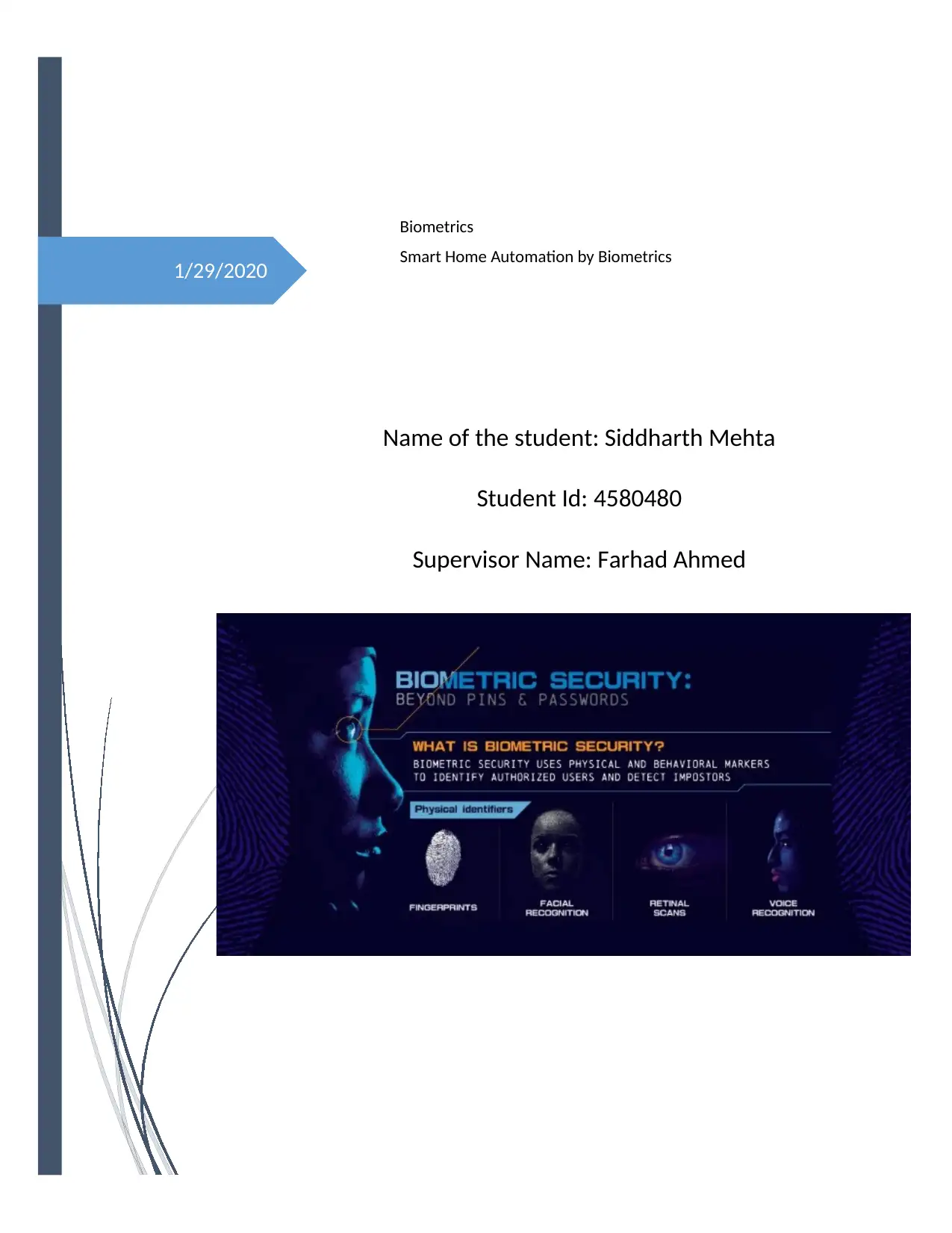
1/29/2020
Biometrics
Smart Home Automation by Biometrics
Name of the student: Siddharth Mehta
Student Id: 4580480
Supervisor Name: Farhad Ahmed
Biometrics
Smart Home Automation by Biometrics
Name of the student: Siddharth Mehta
Student Id: 4580480
Supervisor Name: Farhad Ahmed
Paraphrase This Document
Need a fresh take? Get an instant paraphrase of this document with our AI Paraphraser
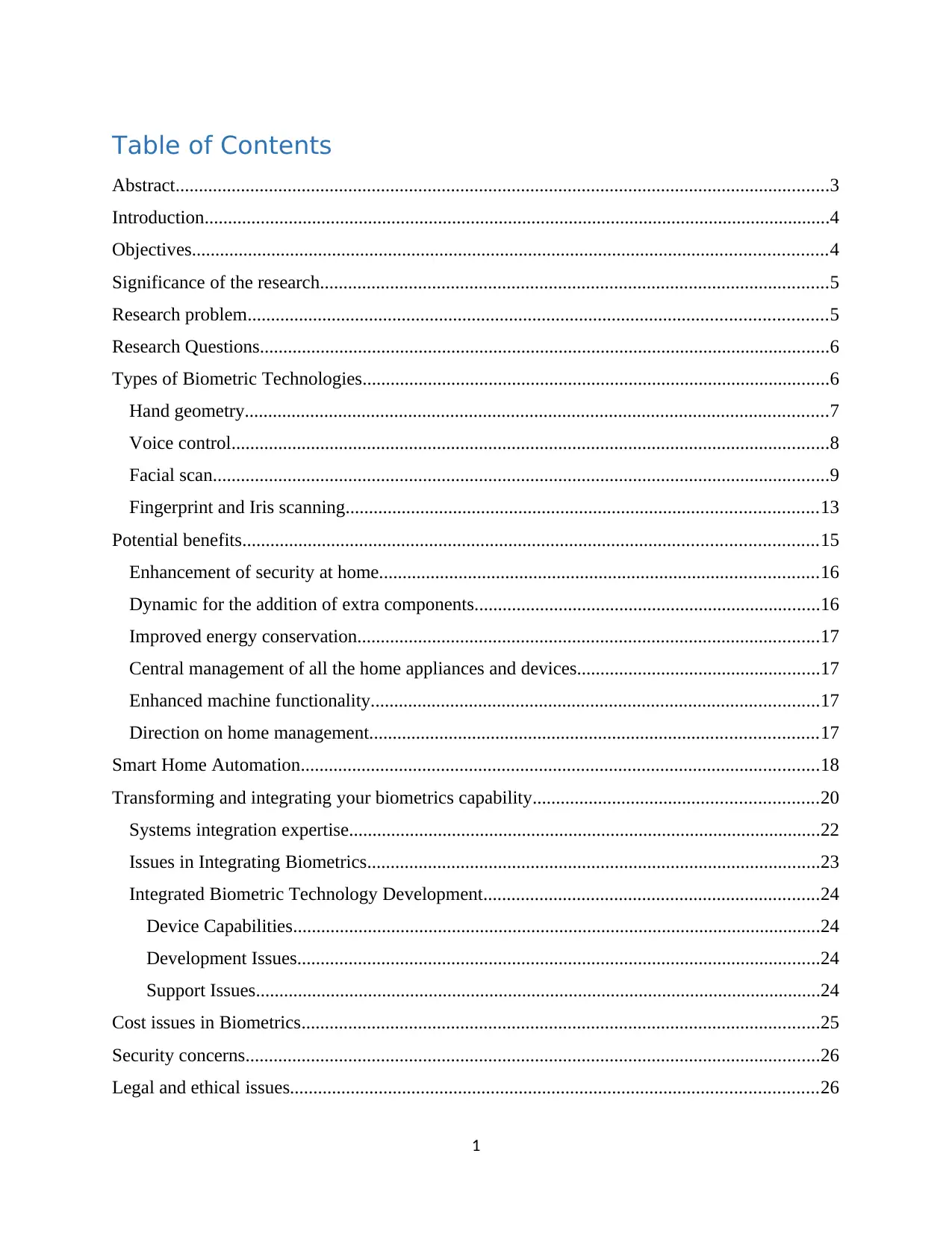
Table of Contents
Abstract............................................................................................................................................3
Introduction......................................................................................................................................4
Objectives........................................................................................................................................4
Significance of the research.............................................................................................................5
Research problem............................................................................................................................5
Research Questions..........................................................................................................................6
Types of Biometric Technologies....................................................................................................6
Hand geometry.............................................................................................................................7
Voice control................................................................................................................................8
Facial scan....................................................................................................................................9
Fingerprint and Iris scanning.....................................................................................................13
Potential benefits...........................................................................................................................15
Enhancement of security at home..............................................................................................16
Dynamic for the addition of extra components..........................................................................16
Improved energy conservation...................................................................................................17
Central management of all the home appliances and devices....................................................17
Enhanced machine functionality................................................................................................17
Direction on home management................................................................................................17
Smart Home Automation...............................................................................................................18
Transforming and integrating your biometrics capability.............................................................20
Systems integration expertise.....................................................................................................22
Issues in Integrating Biometrics.................................................................................................23
Integrated Biometric Technology Development........................................................................24
Device Capabilities.................................................................................................................24
Development Issues................................................................................................................24
Support Issues.........................................................................................................................24
Cost issues in Biometrics...............................................................................................................25
Security concerns...........................................................................................................................26
Legal and ethical issues.................................................................................................................26
1
Abstract............................................................................................................................................3
Introduction......................................................................................................................................4
Objectives........................................................................................................................................4
Significance of the research.............................................................................................................5
Research problem............................................................................................................................5
Research Questions..........................................................................................................................6
Types of Biometric Technologies....................................................................................................6
Hand geometry.............................................................................................................................7
Voice control................................................................................................................................8
Facial scan....................................................................................................................................9
Fingerprint and Iris scanning.....................................................................................................13
Potential benefits...........................................................................................................................15
Enhancement of security at home..............................................................................................16
Dynamic for the addition of extra components..........................................................................16
Improved energy conservation...................................................................................................17
Central management of all the home appliances and devices....................................................17
Enhanced machine functionality................................................................................................17
Direction on home management................................................................................................17
Smart Home Automation...............................................................................................................18
Transforming and integrating your biometrics capability.............................................................20
Systems integration expertise.....................................................................................................22
Issues in Integrating Biometrics.................................................................................................23
Integrated Biometric Technology Development........................................................................24
Device Capabilities.................................................................................................................24
Development Issues................................................................................................................24
Support Issues.........................................................................................................................24
Cost issues in Biometrics...............................................................................................................25
Security concerns...........................................................................................................................26
Legal and ethical issues.................................................................................................................26
1
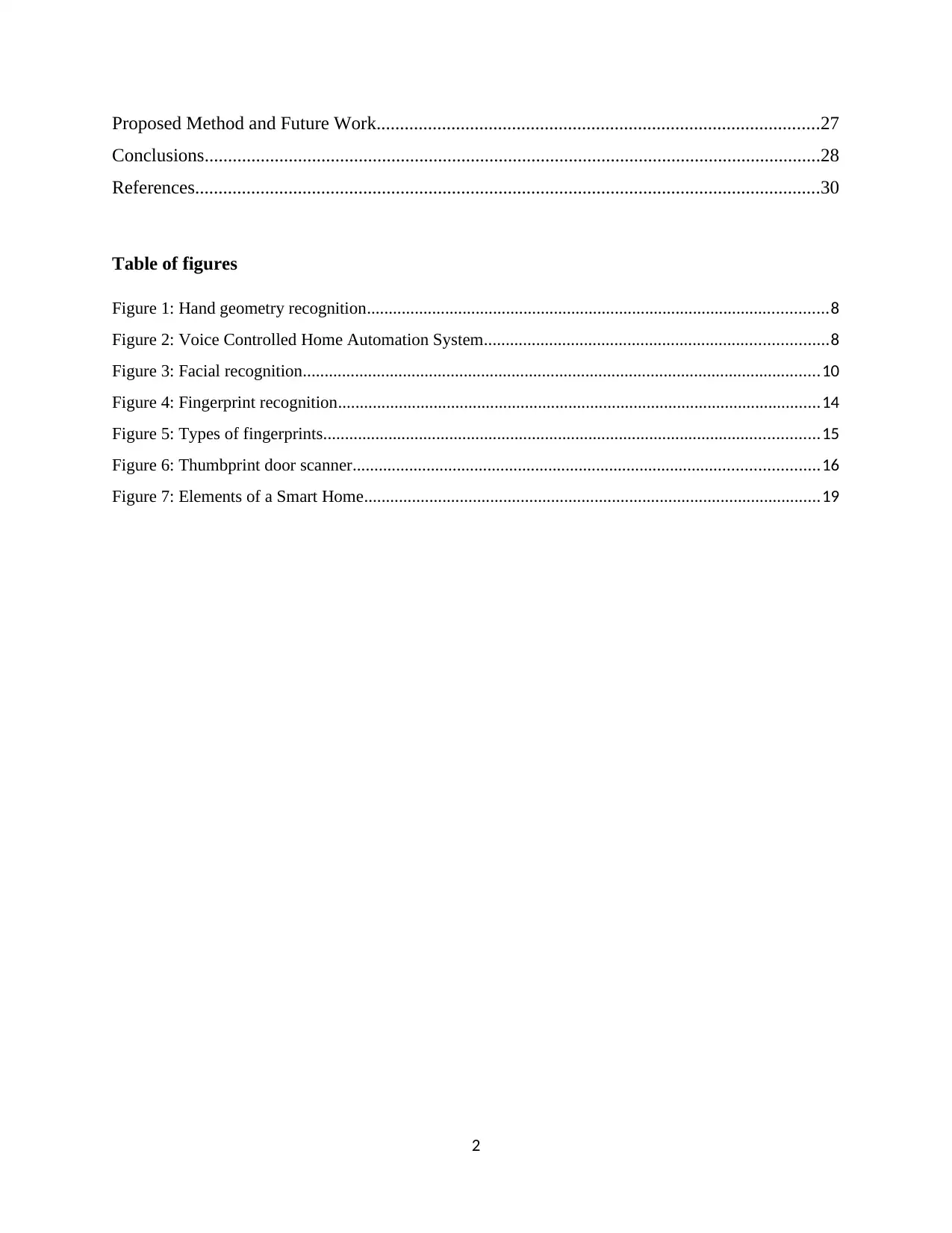
Proposed Method and Future Work...............................................................................................27
Conclusions....................................................................................................................................28
References......................................................................................................................................30
Table of figures
Figure 1: Hand geometry recognition..........................................................................................................8
Figure 2: Voice Controlled Home Automation System...............................................................................8
Figure 3: Facial recognition.......................................................................................................................10
Figure 4: Fingerprint recognition...............................................................................................................14
Figure 5: Types of fingerprints..................................................................................................................15
Figure 6: Thumbprint door scanner...........................................................................................................16
Figure 7: Elements of a Smart Home.........................................................................................................19
2
Conclusions....................................................................................................................................28
References......................................................................................................................................30
Table of figures
Figure 1: Hand geometry recognition..........................................................................................................8
Figure 2: Voice Controlled Home Automation System...............................................................................8
Figure 3: Facial recognition.......................................................................................................................10
Figure 4: Fingerprint recognition...............................................................................................................14
Figure 5: Types of fingerprints..................................................................................................................15
Figure 6: Thumbprint door scanner...........................................................................................................16
Figure 7: Elements of a Smart Home.........................................................................................................19
2
⊘ This is a preview!⊘
Do you want full access?
Subscribe today to unlock all pages.

Trusted by 1+ million students worldwide
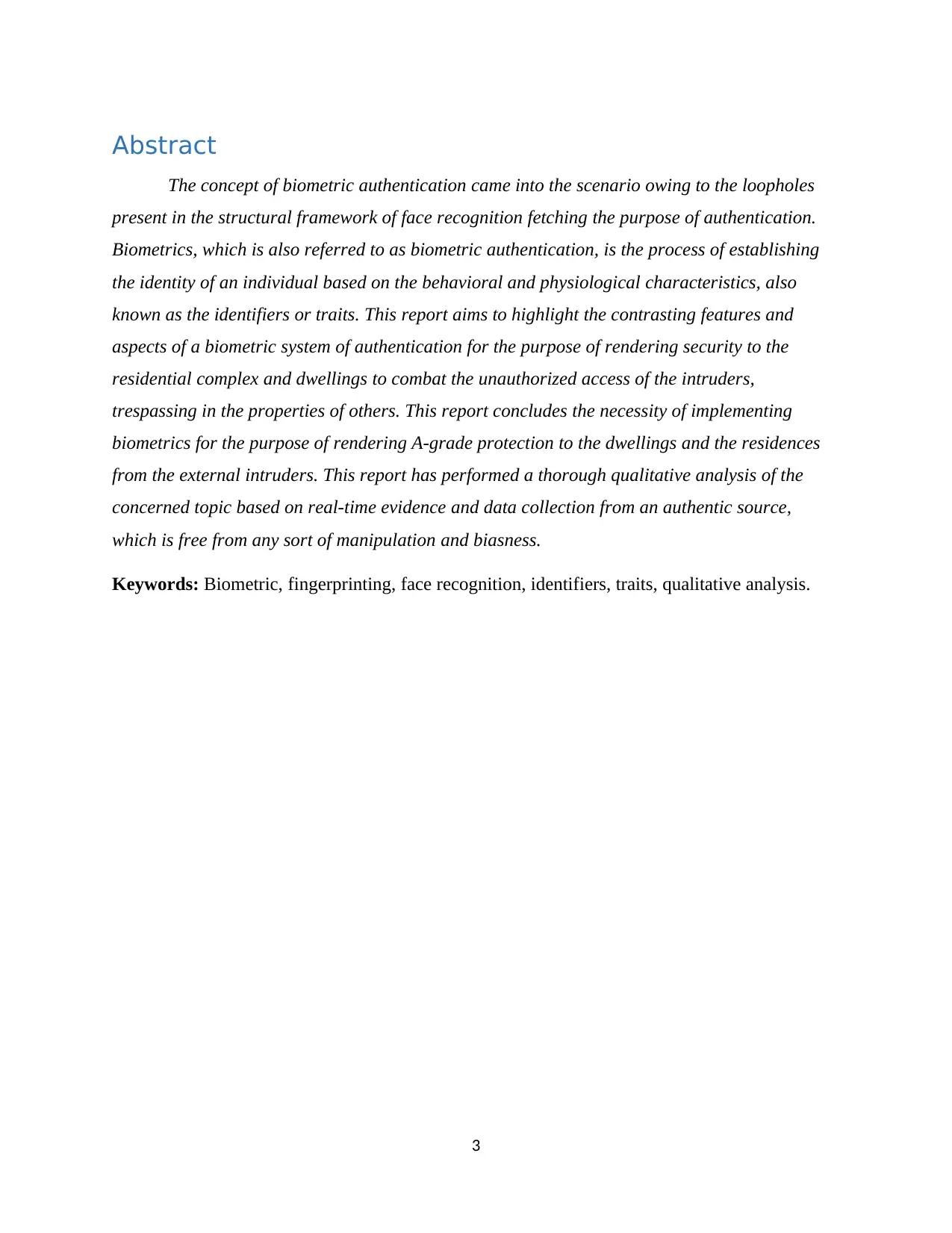
Abstract
The concept of biometric authentication came into the scenario owing to the loopholes
present in the structural framework of face recognition fetching the purpose of authentication.
Biometrics, which is also referred to as biometric authentication, is the process of establishing
the identity of an individual based on the behavioral and physiological characteristics, also
known as the identifiers or traits. This report aims to highlight the contrasting features and
aspects of a biometric system of authentication for the purpose of rendering security to the
residential complex and dwellings to combat the unauthorized access of the intruders,
trespassing in the properties of others. This report concludes the necessity of implementing
biometrics for the purpose of rendering A-grade protection to the dwellings and the residences
from the external intruders. This report has performed a thorough qualitative analysis of the
concerned topic based on real-time evidence and data collection from an authentic source,
which is free from any sort of manipulation and biasness.
Keywords: Biometric, fingerprinting, face recognition, identifiers, traits, qualitative analysis.
3
The concept of biometric authentication came into the scenario owing to the loopholes
present in the structural framework of face recognition fetching the purpose of authentication.
Biometrics, which is also referred to as biometric authentication, is the process of establishing
the identity of an individual based on the behavioral and physiological characteristics, also
known as the identifiers or traits. This report aims to highlight the contrasting features and
aspects of a biometric system of authentication for the purpose of rendering security to the
residential complex and dwellings to combat the unauthorized access of the intruders,
trespassing in the properties of others. This report concludes the necessity of implementing
biometrics for the purpose of rendering A-grade protection to the dwellings and the residences
from the external intruders. This report has performed a thorough qualitative analysis of the
concerned topic based on real-time evidence and data collection from an authentic source,
which is free from any sort of manipulation and biasness.
Keywords: Biometric, fingerprinting, face recognition, identifiers, traits, qualitative analysis.
3
Paraphrase This Document
Need a fresh take? Get an instant paraphrase of this document with our AI Paraphraser
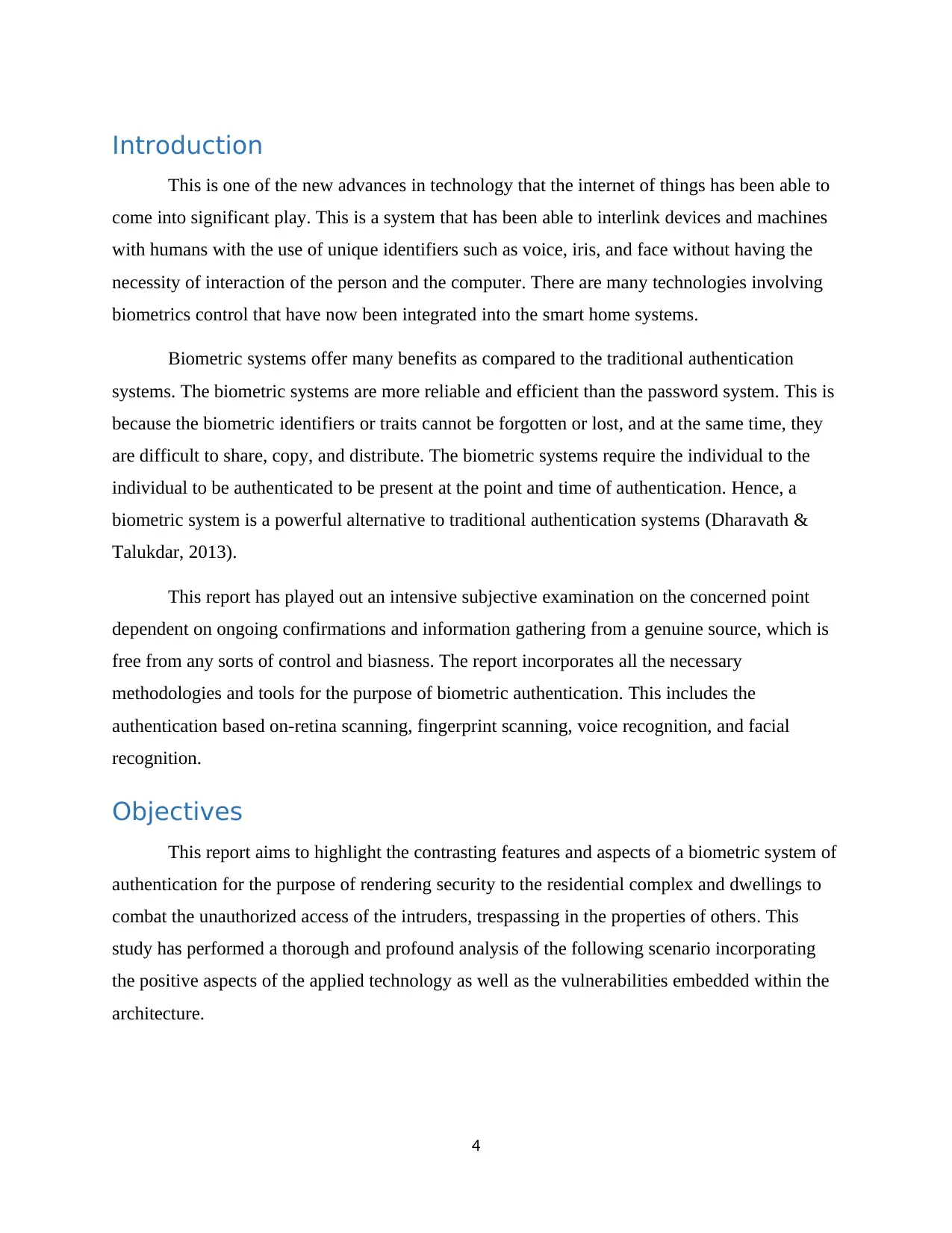
Introduction
This is one of the new advances in technology that the internet of things has been able to
come into significant play. This is a system that has been able to interlink devices and machines
with humans with the use of unique identifiers such as voice, iris, and face without having the
necessity of interaction of the person and the computer. There are many technologies involving
biometrics control that have now been integrated into the smart home systems.
Biometric systems offer many benefits as compared to the traditional authentication
systems. The biometric systems are more reliable and efficient than the password system. This is
because the biometric identifiers or traits cannot be forgotten or lost, and at the same time, they
are difficult to share, copy, and distribute. The biometric systems require the individual to the
individual to be authenticated to be present at the point and time of authentication. Hence, a
biometric system is a powerful alternative to traditional authentication systems (Dharavath &
Talukdar, 2013).
This report has played out an intensive subjective examination on the concerned point
dependent on ongoing confirmations and information gathering from a genuine source, which is
free from any sorts of control and biasness. The report incorporates all the necessary
methodologies and tools for the purpose of biometric authentication. This includes the
authentication based on-retina scanning, fingerprint scanning, voice recognition, and facial
recognition.
Objectives
This report aims to highlight the contrasting features and aspects of a biometric system of
authentication for the purpose of rendering security to the residential complex and dwellings to
combat the unauthorized access of the intruders, trespassing in the properties of others. This
study has performed a thorough and profound analysis of the following scenario incorporating
the positive aspects of the applied technology as well as the vulnerabilities embedded within the
architecture.
4
This is one of the new advances in technology that the internet of things has been able to
come into significant play. This is a system that has been able to interlink devices and machines
with humans with the use of unique identifiers such as voice, iris, and face without having the
necessity of interaction of the person and the computer. There are many technologies involving
biometrics control that have now been integrated into the smart home systems.
Biometric systems offer many benefits as compared to the traditional authentication
systems. The biometric systems are more reliable and efficient than the password system. This is
because the biometric identifiers or traits cannot be forgotten or lost, and at the same time, they
are difficult to share, copy, and distribute. The biometric systems require the individual to the
individual to be authenticated to be present at the point and time of authentication. Hence, a
biometric system is a powerful alternative to traditional authentication systems (Dharavath &
Talukdar, 2013).
This report has played out an intensive subjective examination on the concerned point
dependent on ongoing confirmations and information gathering from a genuine source, which is
free from any sorts of control and biasness. The report incorporates all the necessary
methodologies and tools for the purpose of biometric authentication. This includes the
authentication based on-retina scanning, fingerprint scanning, voice recognition, and facial
recognition.
Objectives
This report aims to highlight the contrasting features and aspects of a biometric system of
authentication for the purpose of rendering security to the residential complex and dwellings to
combat the unauthorized access of the intruders, trespassing in the properties of others. This
study has performed a thorough and profound analysis of the following scenario incorporating
the positive aspects of the applied technology as well as the vulnerabilities embedded within the
architecture.
4
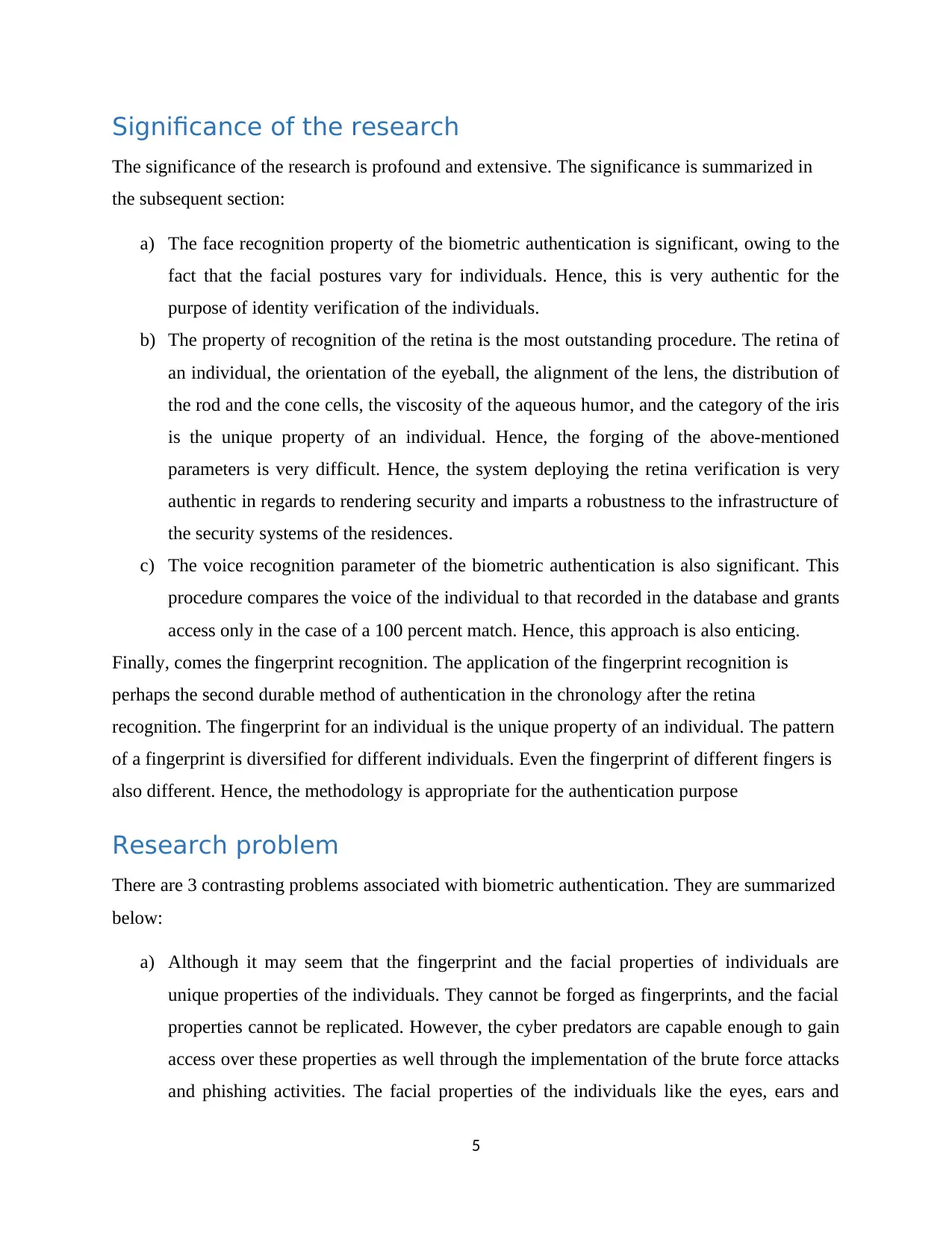
Significance of the research
The significance of the research is profound and extensive. The significance is summarized in
the subsequent section:
a) The face recognition property of the biometric authentication is significant, owing to the
fact that the facial postures vary for individuals. Hence, this is very authentic for the
purpose of identity verification of the individuals.
b) The property of recognition of the retina is the most outstanding procedure. The retina of
an individual, the orientation of the eyeball, the alignment of the lens, the distribution of
the rod and the cone cells, the viscosity of the aqueous humor, and the category of the iris
is the unique property of an individual. Hence, the forging of the above-mentioned
parameters is very difficult. Hence, the system deploying the retina verification is very
authentic in regards to rendering security and imparts a robustness to the infrastructure of
the security systems of the residences.
c) The voice recognition parameter of the biometric authentication is also significant. This
procedure compares the voice of the individual to that recorded in the database and grants
access only in the case of a 100 percent match. Hence, this approach is also enticing.
Finally, comes the fingerprint recognition. The application of the fingerprint recognition is
perhaps the second durable method of authentication in the chronology after the retina
recognition. The fingerprint for an individual is the unique property of an individual. The pattern
of a fingerprint is diversified for different individuals. Even the fingerprint of different fingers is
also different. Hence, the methodology is appropriate for the authentication purpose
Research problem
There are 3 contrasting problems associated with biometric authentication. They are summarized
below:
a) Although it may seem that the fingerprint and the facial properties of individuals are
unique properties of the individuals. They cannot be forged as fingerprints, and the facial
properties cannot be replicated. However, the cyber predators are capable enough to gain
access over these properties as well through the implementation of the brute force attacks
and phishing activities. The facial properties of the individuals like the eyes, ears and
5
The significance of the research is profound and extensive. The significance is summarized in
the subsequent section:
a) The face recognition property of the biometric authentication is significant, owing to the
fact that the facial postures vary for individuals. Hence, this is very authentic for the
purpose of identity verification of the individuals.
b) The property of recognition of the retina is the most outstanding procedure. The retina of
an individual, the orientation of the eyeball, the alignment of the lens, the distribution of
the rod and the cone cells, the viscosity of the aqueous humor, and the category of the iris
is the unique property of an individual. Hence, the forging of the above-mentioned
parameters is very difficult. Hence, the system deploying the retina verification is very
authentic in regards to rendering security and imparts a robustness to the infrastructure of
the security systems of the residences.
c) The voice recognition parameter of the biometric authentication is also significant. This
procedure compares the voice of the individual to that recorded in the database and grants
access only in the case of a 100 percent match. Hence, this approach is also enticing.
Finally, comes the fingerprint recognition. The application of the fingerprint recognition is
perhaps the second durable method of authentication in the chronology after the retina
recognition. The fingerprint for an individual is the unique property of an individual. The pattern
of a fingerprint is diversified for different individuals. Even the fingerprint of different fingers is
also different. Hence, the methodology is appropriate for the authentication purpose
Research problem
There are 3 contrasting problems associated with biometric authentication. They are summarized
below:
a) Although it may seem that the fingerprint and the facial properties of individuals are
unique properties of the individuals. They cannot be forged as fingerprints, and the facial
properties cannot be replicated. However, the cyber predators are capable enough to gain
access over these properties as well through the implementation of the brute force attacks
and phishing activities. The facial properties of the individuals like the eyes, ears and
5
⊘ This is a preview!⊘
Do you want full access?
Subscribe today to unlock all pages.

Trusted by 1+ million students worldwide
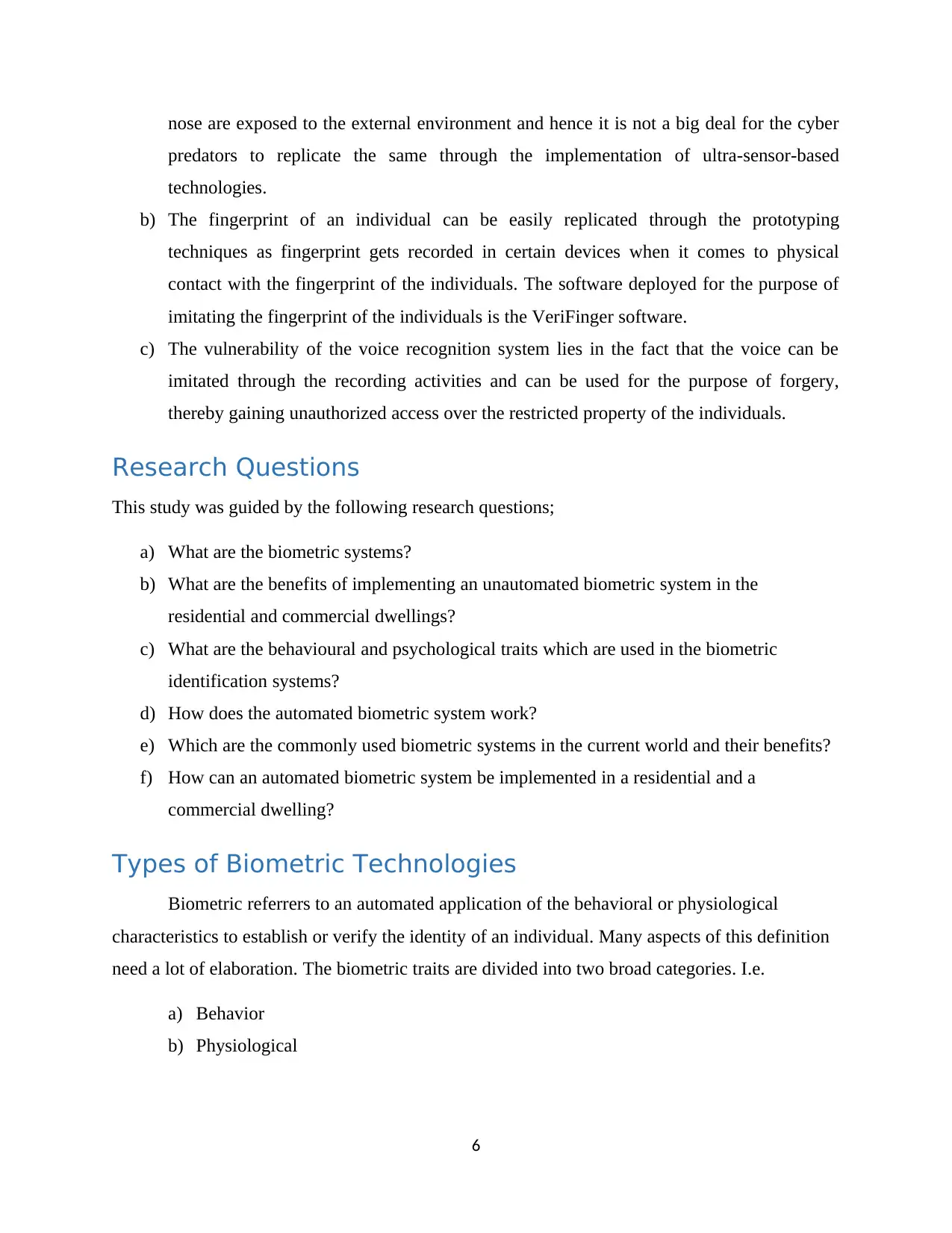
nose are exposed to the external environment and hence it is not a big deal for the cyber
predators to replicate the same through the implementation of ultra-sensor-based
technologies.
b) The fingerprint of an individual can be easily replicated through the prototyping
techniques as fingerprint gets recorded in certain devices when it comes to physical
contact with the fingerprint of the individuals. The software deployed for the purpose of
imitating the fingerprint of the individuals is the VeriFinger software.
c) The vulnerability of the voice recognition system lies in the fact that the voice can be
imitated through the recording activities and can be used for the purpose of forgery,
thereby gaining unauthorized access over the restricted property of the individuals.
Research Questions
This study was guided by the following research questions;
a) What are the biometric systems?
b) What are the benefits of implementing an unautomated biometric system in the
residential and commercial dwellings?
c) What are the behavioural and psychological traits which are used in the biometric
identification systems?
d) How does the automated biometric system work?
e) Which are the commonly used biometric systems in the current world and their benefits?
f) How can an automated biometric system be implemented in a residential and a
commercial dwelling?
Types of Biometric Technologies
Biometric referrers to an automated application of the behavioral or physiological
characteristics to establish or verify the identity of an individual. Many aspects of this definition
need a lot of elaboration. The biometric traits are divided into two broad categories. I.e.
a) Behavior
b) Physiological
6
predators to replicate the same through the implementation of ultra-sensor-based
technologies.
b) The fingerprint of an individual can be easily replicated through the prototyping
techniques as fingerprint gets recorded in certain devices when it comes to physical
contact with the fingerprint of the individuals. The software deployed for the purpose of
imitating the fingerprint of the individuals is the VeriFinger software.
c) The vulnerability of the voice recognition system lies in the fact that the voice can be
imitated through the recording activities and can be used for the purpose of forgery,
thereby gaining unauthorized access over the restricted property of the individuals.
Research Questions
This study was guided by the following research questions;
a) What are the biometric systems?
b) What are the benefits of implementing an unautomated biometric system in the
residential and commercial dwellings?
c) What are the behavioural and psychological traits which are used in the biometric
identification systems?
d) How does the automated biometric system work?
e) Which are the commonly used biometric systems in the current world and their benefits?
f) How can an automated biometric system be implemented in a residential and a
commercial dwelling?
Types of Biometric Technologies
Biometric referrers to an automated application of the behavioral or physiological
characteristics to establish or verify the identity of an individual. Many aspects of this definition
need a lot of elaboration. The biometric traits are divided into two broad categories. I.e.
a) Behavior
b) Physiological
6
Paraphrase This Document
Need a fresh take? Get an instant paraphrase of this document with our AI Paraphraser
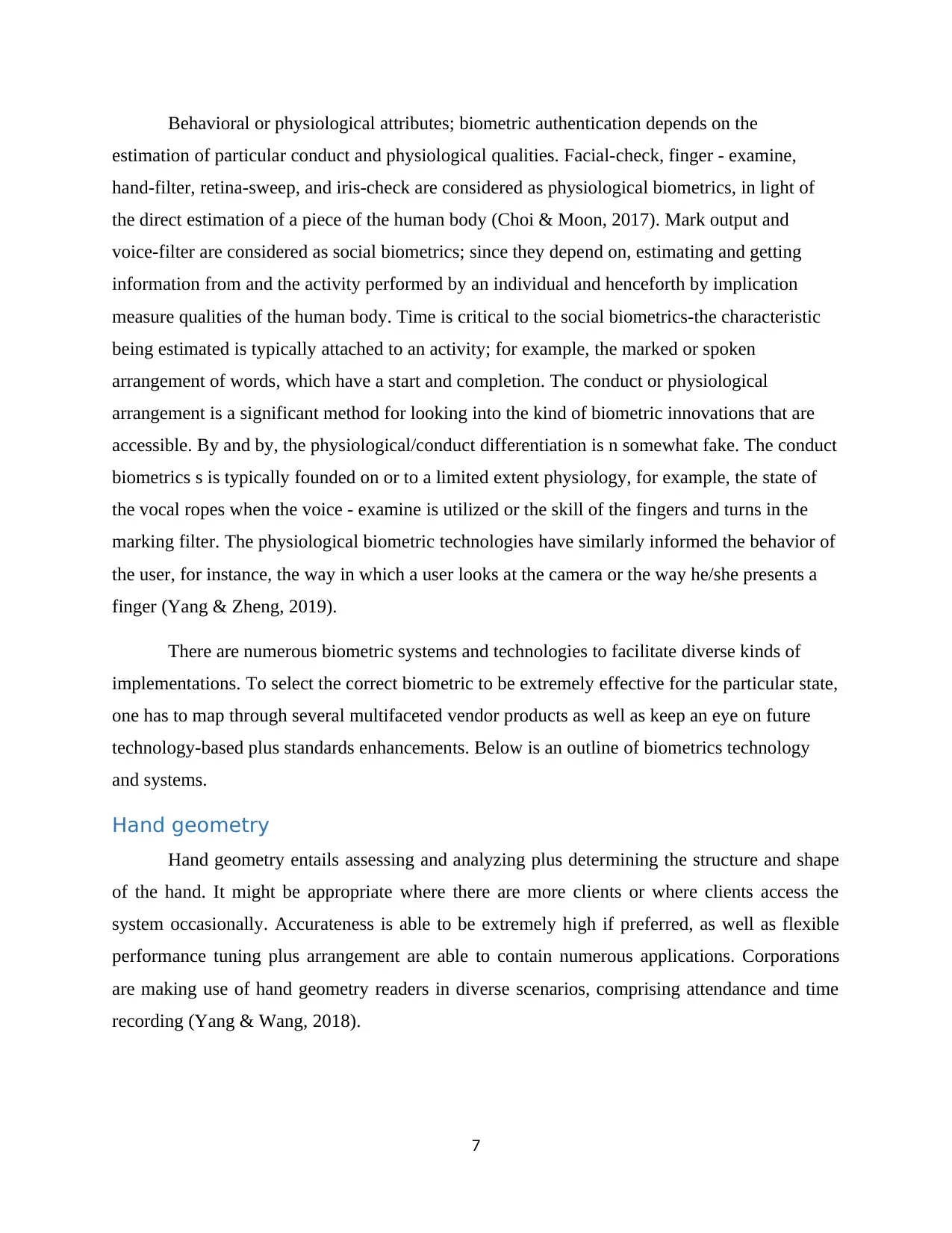
Behavioral or physiological attributes; biometric authentication depends on the
estimation of particular conduct and physiological qualities. Facial-check, finger - examine,
hand-filter, retina-sweep, and iris-check are considered as physiological biometrics, in light of
the direct estimation of a piece of the human body (Choi & Moon, 2017). Mark output and
voice-filter are considered as social biometrics; since they depend on, estimating and getting
information from and the activity performed by an individual and henceforth by implication
measure qualities of the human body. Time is critical to the social biometrics-the characteristic
being estimated is typically attached to an activity; for example, the marked or spoken
arrangement of words, which have a start and completion. The conduct or physiological
arrangement is a significant method for looking into the kind of biometric innovations that are
accessible. By and by, the physiological/conduct differentiation is n somewhat fake. The conduct
biometrics s is typically founded on or to a limited extent physiology, for example, the state of
the vocal ropes when the voice - examine is utilized or the skill of the fingers and turns in the
marking filter. The physiological biometric technologies have similarly informed the behavior of
the user, for instance, the way in which a user looks at the camera or the way he/she presents a
finger (Yang & Zheng, 2019).
There are numerous biometric systems and technologies to facilitate diverse kinds of
implementations. To select the correct biometric to be extremely effective for the particular state,
one has to map through several multifaceted vendor products as well as keep an eye on future
technology-based plus standards enhancements. Below is an outline of biometrics technology
and systems.
Hand geometry
Hand geometry entails assessing and analyzing plus determining the structure and shape
of the hand. It might be appropriate where there are more clients or where clients access the
system occasionally. Accurateness is able to be extremely high if preferred, as well as flexible
performance tuning plus arrangement are able to contain numerous applications. Corporations
are making use of hand geometry readers in diverse scenarios, comprising attendance and time
recording (Yang & Wang, 2018).
7
estimation of particular conduct and physiological qualities. Facial-check, finger - examine,
hand-filter, retina-sweep, and iris-check are considered as physiological biometrics, in light of
the direct estimation of a piece of the human body (Choi & Moon, 2017). Mark output and
voice-filter are considered as social biometrics; since they depend on, estimating and getting
information from and the activity performed by an individual and henceforth by implication
measure qualities of the human body. Time is critical to the social biometrics-the characteristic
being estimated is typically attached to an activity; for example, the marked or spoken
arrangement of words, which have a start and completion. The conduct or physiological
arrangement is a significant method for looking into the kind of biometric innovations that are
accessible. By and by, the physiological/conduct differentiation is n somewhat fake. The conduct
biometrics s is typically founded on or to a limited extent physiology, for example, the state of
the vocal ropes when the voice - examine is utilized or the skill of the fingers and turns in the
marking filter. The physiological biometric technologies have similarly informed the behavior of
the user, for instance, the way in which a user looks at the camera or the way he/she presents a
finger (Yang & Zheng, 2019).
There are numerous biometric systems and technologies to facilitate diverse kinds of
implementations. To select the correct biometric to be extremely effective for the particular state,
one has to map through several multifaceted vendor products as well as keep an eye on future
technology-based plus standards enhancements. Below is an outline of biometrics technology
and systems.
Hand geometry
Hand geometry entails assessing and analyzing plus determining the structure and shape
of the hand. It might be appropriate where there are more clients or where clients access the
system occasionally. Accurateness is able to be extremely high if preferred, as well as flexible
performance tuning plus arrangement are able to contain numerous applications. Corporations
are making use of hand geometry readers in diverse scenarios, comprising attendance and time
recording (Yang & Wang, 2018).
7
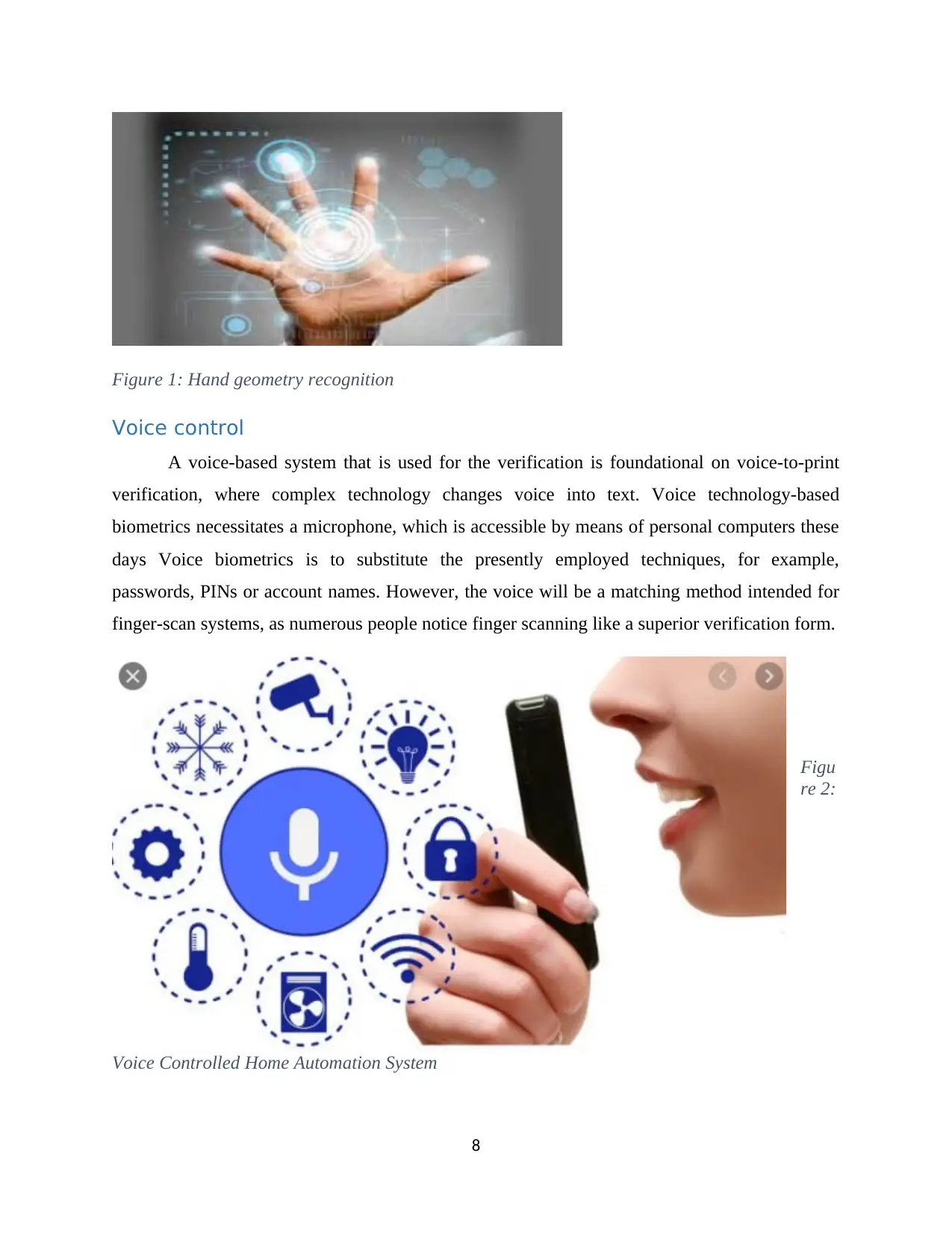
Figure 1: Hand geometry recognition
Voice control
A voice-based system that is used for the verification is foundational on voice-to-print
verification, where complex technology changes voice into text. Voice technology-based
biometrics necessitates a microphone, which is accessible by means of personal computers these
days Voice biometrics is to substitute the presently employed techniques, for example,
passwords, PINs or account names. However, the voice will be a matching method intended for
finger-scan systems, as numerous people notice finger scanning like a superior verification form.
Figu
re 2:
Voice Controlled Home Automation System
8
Voice control
A voice-based system that is used for the verification is foundational on voice-to-print
verification, where complex technology changes voice into text. Voice technology-based
biometrics necessitates a microphone, which is accessible by means of personal computers these
days Voice biometrics is to substitute the presently employed techniques, for example,
passwords, PINs or account names. However, the voice will be a matching method intended for
finger-scan systems, as numerous people notice finger scanning like a superior verification form.
Figu
re 2:
Voice Controlled Home Automation System
8
⊘ This is a preview!⊘
Do you want full access?
Subscribe today to unlock all pages.

Trusted by 1+ million students worldwide
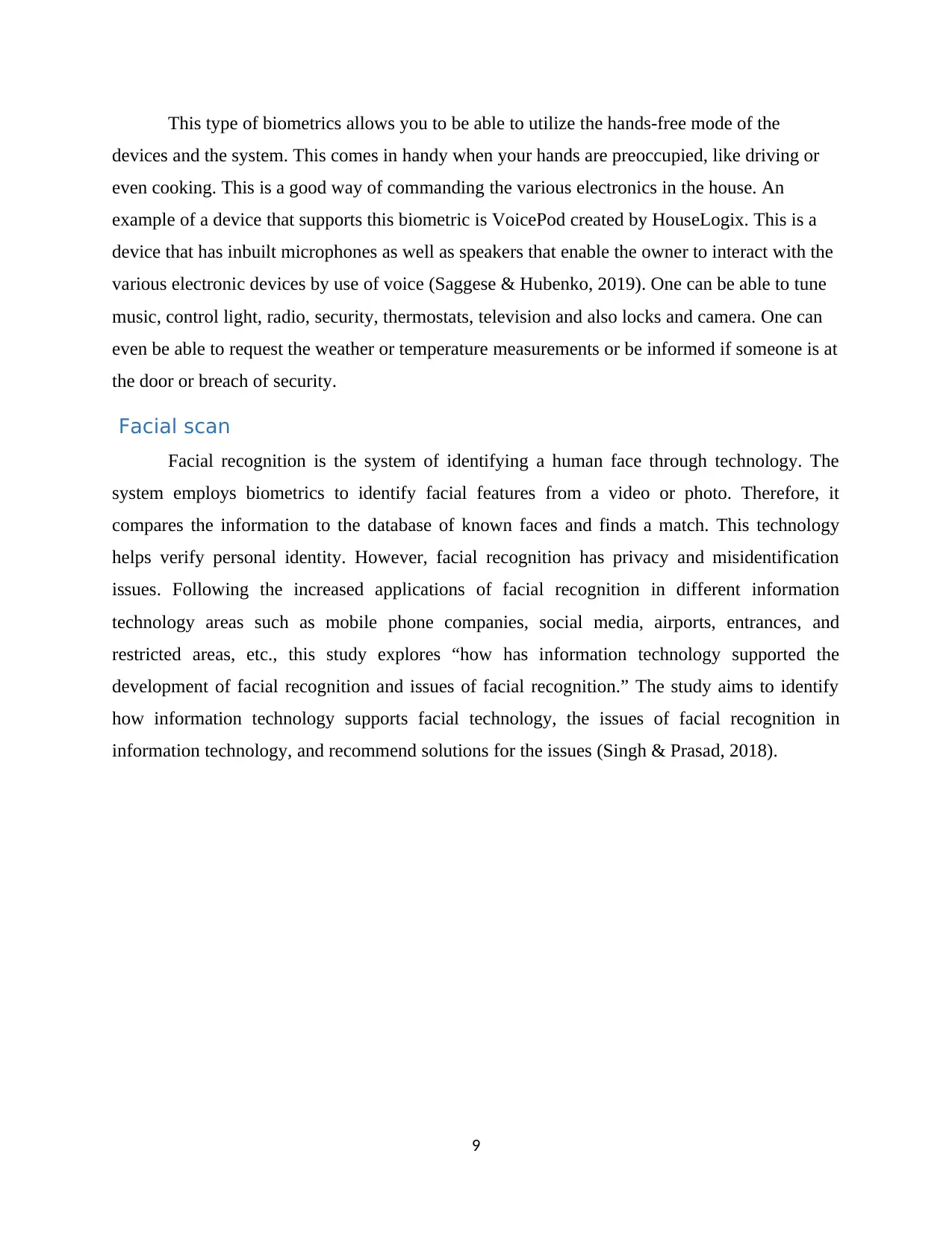
This type of biometrics allows you to be able to utilize the hands-free mode of the
devices and the system. This comes in handy when your hands are preoccupied, like driving or
even cooking. This is a good way of commanding the various electronics in the house. An
example of a device that supports this biometric is VoicePod created by HouseLogix. This is a
device that has inbuilt microphones as well as speakers that enable the owner to interact with the
various electronic devices by use of voice (Saggese & Hubenko, 2019). One can be able to tune
music, control light, radio, security, thermostats, television and also locks and camera. One can
even be able to request the weather or temperature measurements or be informed if someone is at
the door or breach of security.
Facial scan
Facial recognition is the system of identifying a human face through technology. The
system employs biometrics to identify facial features from a video or photo. Therefore, it
compares the information to the database of known faces and finds a match. This technology
helps verify personal identity. However, facial recognition has privacy and misidentification
issues. Following the increased applications of facial recognition in different information
technology areas such as mobile phone companies, social media, airports, entrances, and
restricted areas, etc., this study explores “how has information technology supported the
development of facial recognition and issues of facial recognition.” The study aims to identify
how information technology supports facial technology, the issues of facial recognition in
information technology, and recommend solutions for the issues (Singh & Prasad, 2018).
9
devices and the system. This comes in handy when your hands are preoccupied, like driving or
even cooking. This is a good way of commanding the various electronics in the house. An
example of a device that supports this biometric is VoicePod created by HouseLogix. This is a
device that has inbuilt microphones as well as speakers that enable the owner to interact with the
various electronic devices by use of voice (Saggese & Hubenko, 2019). One can be able to tune
music, control light, radio, security, thermostats, television and also locks and camera. One can
even be able to request the weather or temperature measurements or be informed if someone is at
the door or breach of security.
Facial scan
Facial recognition is the system of identifying a human face through technology. The
system employs biometrics to identify facial features from a video or photo. Therefore, it
compares the information to the database of known faces and finds a match. This technology
helps verify personal identity. However, facial recognition has privacy and misidentification
issues. Following the increased applications of facial recognition in different information
technology areas such as mobile phone companies, social media, airports, entrances, and
restricted areas, etc., this study explores “how has information technology supported the
development of facial recognition and issues of facial recognition.” The study aims to identify
how information technology supports facial technology, the issues of facial recognition in
information technology, and recommend solutions for the issues (Singh & Prasad, 2018).
9
Paraphrase This Document
Need a fresh take? Get an instant paraphrase of this document with our AI Paraphraser
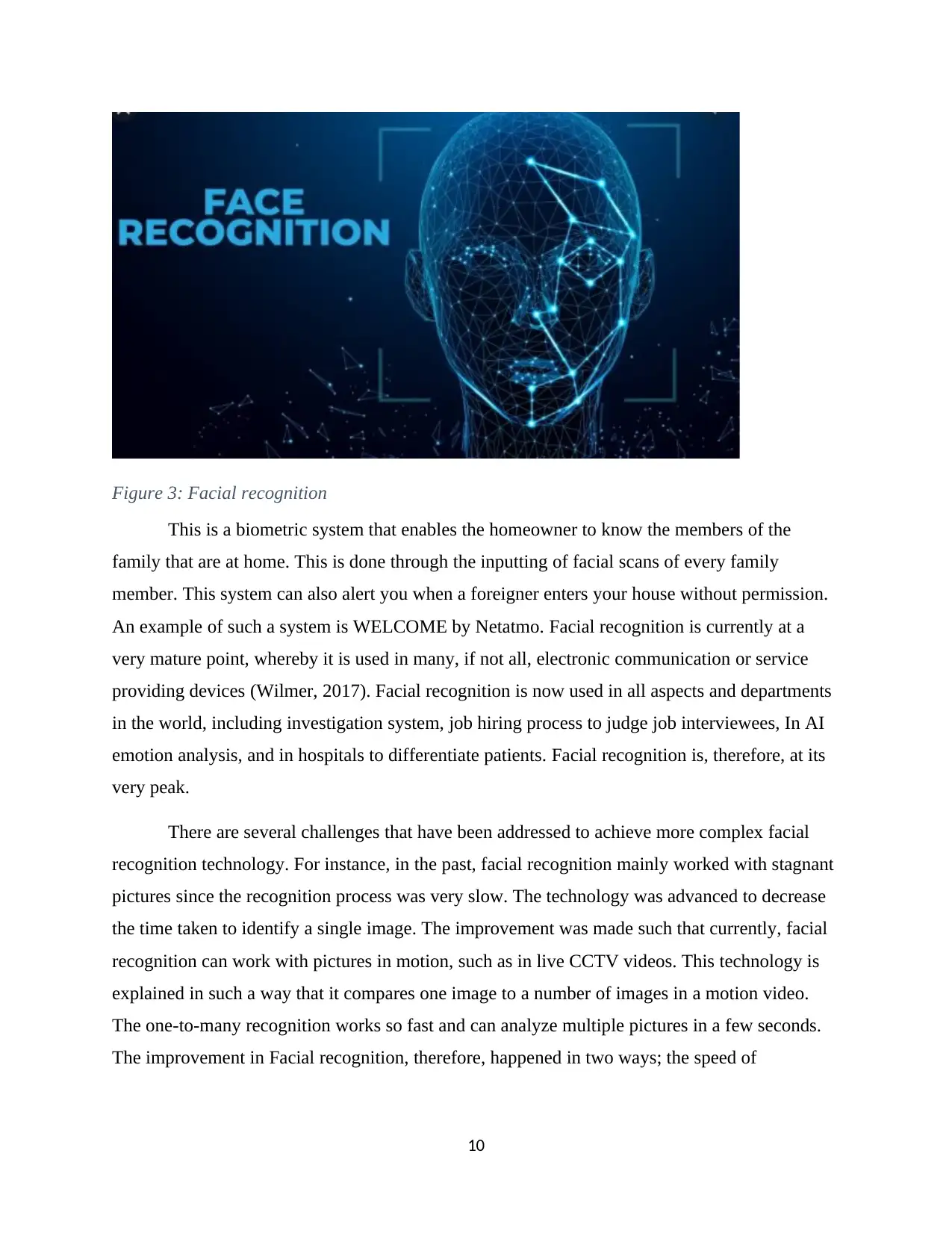
Figure 3: Facial recognition
This is a biometric system that enables the homeowner to know the members of the
family that are at home. This is done through the inputting of facial scans of every family
member. This system can also alert you when a foreigner enters your house without permission.
An example of such a system is WELCOME by Netatmo. Facial recognition is currently at a
very mature point, whereby it is used in many, if not all, electronic communication or service
providing devices (Wilmer, 2017). Facial recognition is now used in all aspects and departments
in the world, including investigation system, job hiring process to judge job interviewees, In AI
emotion analysis, and in hospitals to differentiate patients. Facial recognition is, therefore, at its
very peak.
There are several challenges that have been addressed to achieve more complex facial
recognition technology. For instance, in the past, facial recognition mainly worked with stagnant
pictures since the recognition process was very slow. The technology was advanced to decrease
the time taken to identify a single image. The improvement was made such that currently, facial
recognition can work with pictures in motion, such as in live CCTV videos. This technology is
explained in such a way that it compares one image to a number of images in a motion video.
The one-to-many recognition works so fast and can analyze multiple pictures in a few seconds.
The improvement in Facial recognition, therefore, happened in two ways; the speed of
10
This is a biometric system that enables the homeowner to know the members of the
family that are at home. This is done through the inputting of facial scans of every family
member. This system can also alert you when a foreigner enters your house without permission.
An example of such a system is WELCOME by Netatmo. Facial recognition is currently at a
very mature point, whereby it is used in many, if not all, electronic communication or service
providing devices (Wilmer, 2017). Facial recognition is now used in all aspects and departments
in the world, including investigation system, job hiring process to judge job interviewees, In AI
emotion analysis, and in hospitals to differentiate patients. Facial recognition is, therefore, at its
very peak.
There are several challenges that have been addressed to achieve more complex facial
recognition technology. For instance, in the past, facial recognition mainly worked with stagnant
pictures since the recognition process was very slow. The technology was advanced to decrease
the time taken to identify a single image. The improvement was made such that currently, facial
recognition can work with pictures in motion, such as in live CCTV videos. This technology is
explained in such a way that it compares one image to a number of images in a motion video.
The one-to-many recognition works so fast and can analyze multiple pictures in a few seconds.
The improvement in Facial recognition, therefore, happened in two ways; the speed of
10
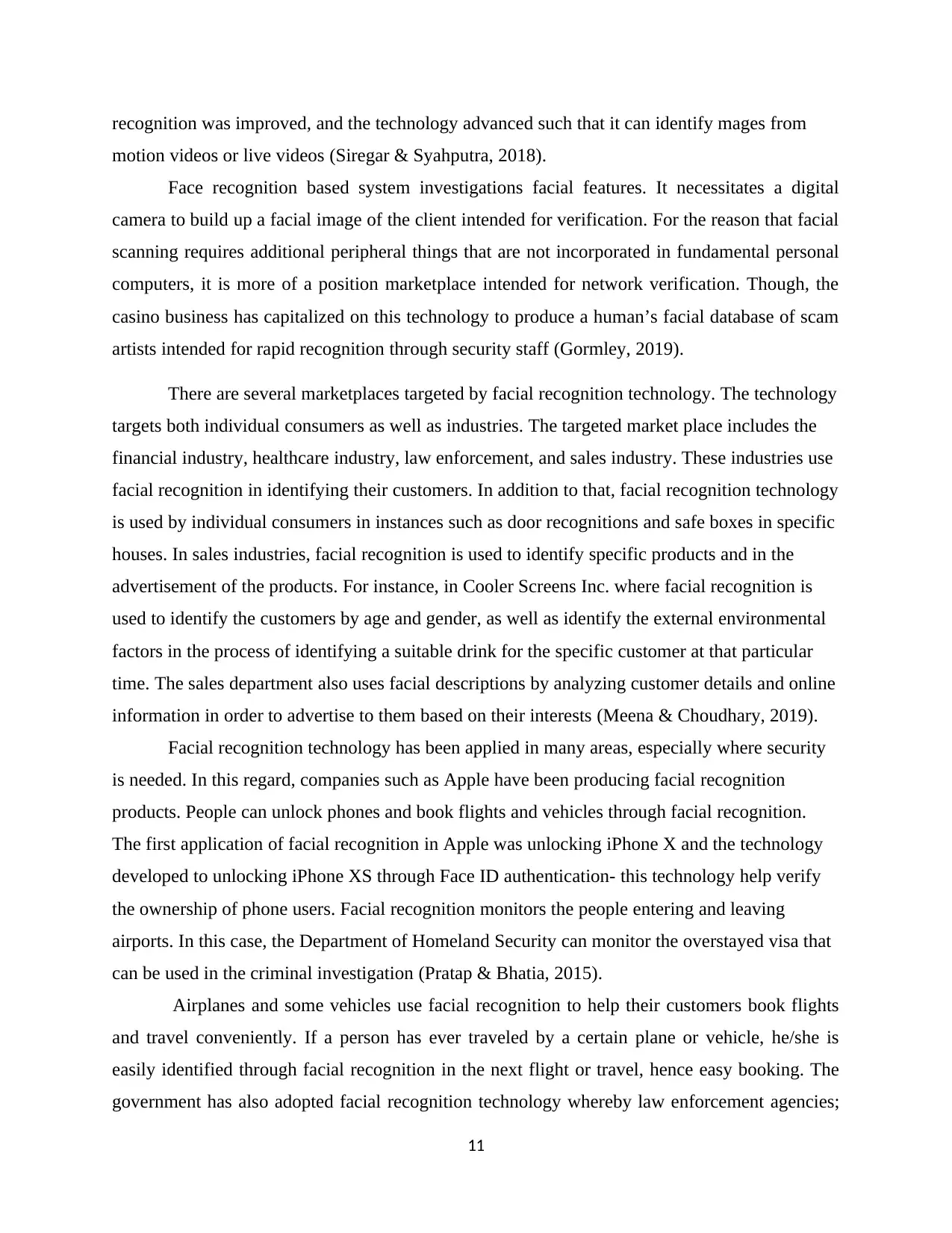
recognition was improved, and the technology advanced such that it can identify mages from
motion videos or live videos (Siregar & Syahputra, 2018).
Face recognition based system investigations facial features. It necessitates a digital
camera to build up a facial image of the client intended for verification. For the reason that facial
scanning requires additional peripheral things that are not incorporated in fundamental personal
computers, it is more of a position marketplace intended for network verification. Though, the
casino business has capitalized on this technology to produce a human’s facial database of scam
artists intended for rapid recognition through security staff (Gormley, 2019).
There are several marketplaces targeted by facial recognition technology. The technology
targets both individual consumers as well as industries. The targeted market place includes the
financial industry, healthcare industry, law enforcement, and sales industry. These industries use
facial recognition in identifying their customers. In addition to that, facial recognition technology
is used by individual consumers in instances such as door recognitions and safe boxes in specific
houses. In sales industries, facial recognition is used to identify specific products and in the
advertisement of the products. For instance, in Cooler Screens Inc. where facial recognition is
used to identify the customers by age and gender, as well as identify the external environmental
factors in the process of identifying a suitable drink for the specific customer at that particular
time. The sales department also uses facial descriptions by analyzing customer details and online
information in order to advertise to them based on their interests (Meena & Choudhary, 2019).
Facial recognition technology has been applied in many areas, especially where security
is needed. In this regard, companies such as Apple have been producing facial recognition
products. People can unlock phones and book flights and vehicles through facial recognition.
The first application of facial recognition in Apple was unlocking iPhone X and the technology
developed to unlocking iPhone XS through Face ID authentication- this technology help verify
the ownership of phone users. Facial recognition monitors the people entering and leaving
airports. In this case, the Department of Homeland Security can monitor the overstayed visa that
can be used in the criminal investigation (Pratap & Bhatia, 2015).
Airplanes and some vehicles use facial recognition to help their customers book flights
and travel conveniently. If a person has ever traveled by a certain plane or vehicle, he/she is
easily identified through facial recognition in the next flight or travel, hence easy booking. The
government has also adopted facial recognition technology whereby law enforcement agencies;
11
motion videos or live videos (Siregar & Syahputra, 2018).
Face recognition based system investigations facial features. It necessitates a digital
camera to build up a facial image of the client intended for verification. For the reason that facial
scanning requires additional peripheral things that are not incorporated in fundamental personal
computers, it is more of a position marketplace intended for network verification. Though, the
casino business has capitalized on this technology to produce a human’s facial database of scam
artists intended for rapid recognition through security staff (Gormley, 2019).
There are several marketplaces targeted by facial recognition technology. The technology
targets both individual consumers as well as industries. The targeted market place includes the
financial industry, healthcare industry, law enforcement, and sales industry. These industries use
facial recognition in identifying their customers. In addition to that, facial recognition technology
is used by individual consumers in instances such as door recognitions and safe boxes in specific
houses. In sales industries, facial recognition is used to identify specific products and in the
advertisement of the products. For instance, in Cooler Screens Inc. where facial recognition is
used to identify the customers by age and gender, as well as identify the external environmental
factors in the process of identifying a suitable drink for the specific customer at that particular
time. The sales department also uses facial descriptions by analyzing customer details and online
information in order to advertise to them based on their interests (Meena & Choudhary, 2019).
Facial recognition technology has been applied in many areas, especially where security
is needed. In this regard, companies such as Apple have been producing facial recognition
products. People can unlock phones and book flights and vehicles through facial recognition.
The first application of facial recognition in Apple was unlocking iPhone X and the technology
developed to unlocking iPhone XS through Face ID authentication- this technology help verify
the ownership of phone users. Facial recognition monitors the people entering and leaving
airports. In this case, the Department of Homeland Security can monitor the overstayed visa that
can be used in the criminal investigation (Pratap & Bhatia, 2015).
Airplanes and some vehicles use facial recognition to help their customers book flights
and travel conveniently. If a person has ever traveled by a certain plane or vehicle, he/she is
easily identified through facial recognition in the next flight or travel, hence easy booking. The
government has also adopted facial recognition technology whereby law enforcement agencies;
11
⊘ This is a preview!⊘
Do you want full access?
Subscribe today to unlock all pages.

Trusted by 1+ million students worldwide
1 out of 35
Related Documents
Your All-in-One AI-Powered Toolkit for Academic Success.
+13062052269
info@desklib.com
Available 24*7 on WhatsApp / Email
![[object Object]](/_next/static/media/star-bottom.7253800d.svg)
Unlock your academic potential
Copyright © 2020–2025 A2Z Services. All Rights Reserved. Developed and managed by ZUCOL.




